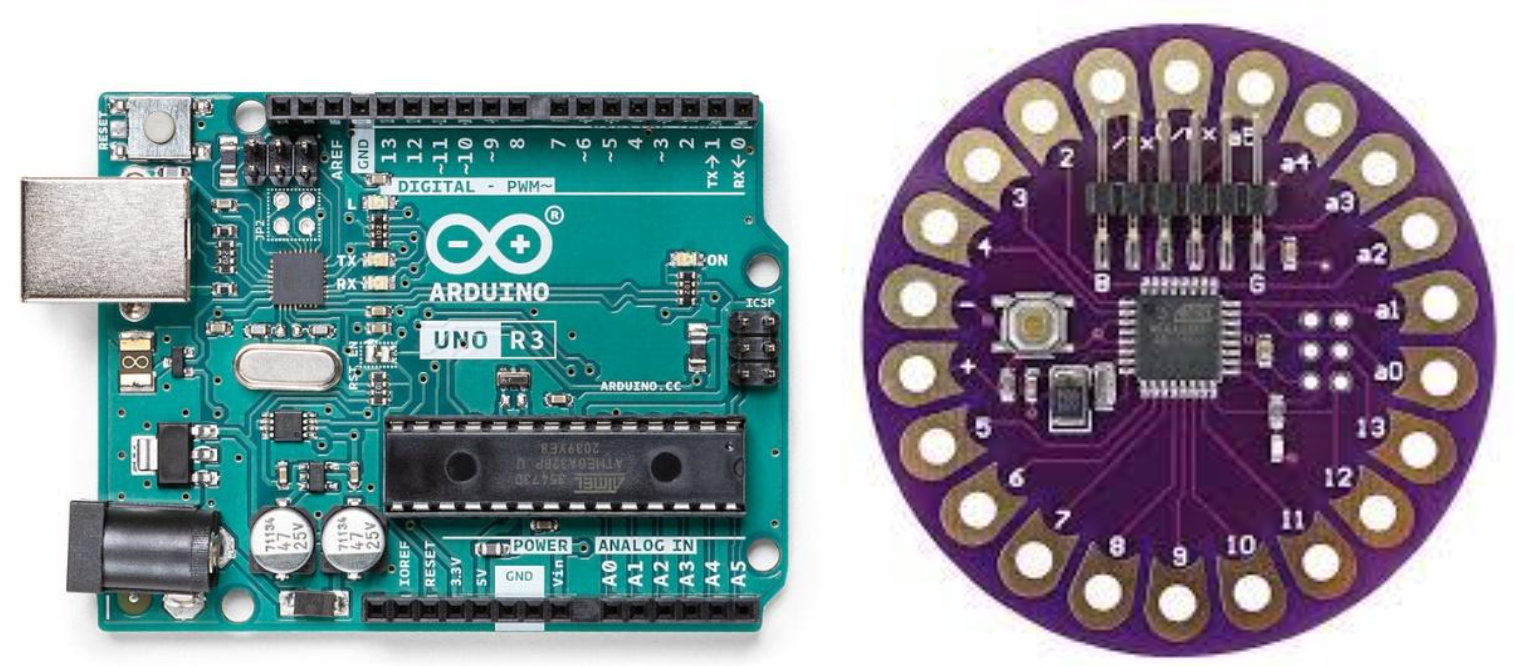Differences Between Arduino UNO and Arduino LilyPad
The Arduino UNO and Arduino LilyPad have many differences including the microcontroller used, memory, methods to power them, clock frequency, input-output pins, serial communication, and some others. These differences are further elaborated below. The Arduino UNO R3 and Arduino LilyPad look like this.

Purpose of Arduino UNO and Arduino LilyPad
The Arduino UNO and Arduino Lily Pad mainly differ in their purpose and usage. The Arduino UNO is used in simple electronic devices whereas the Arduino Lily Pad is used in wearable items and textile products such as clothing, handbags, shoes, and others. It can also be sewn in clothes using connector thread and it is also washable.
Microcontroller
The Arduino UNO mainly uses ATMega328p as a microcontroller. However, this microcontroller can also be replaced with ATMega16U2. The Arduino LilyPad uses ATMega32U4 as a microcontroller in it.
Power Supply
The Arduino UNO can be supplied power using a serial USB connector and through 5V and GND pins. The Arduino LilyPad, on the other hand, has a built-in JST power supply socket that can turn it ON and OFF using the LiPo battery of 3.3V provided by Arduino. It does not have USB serial connector support like Arduino, so an FTDI adapter is required to power it.
Memory
The Arduino LilyPad has a flash memory of 32 KB, with 4 KB reserved for a bootloader. It consists of 2.5 KB SRAM and 1 KB EEPROM. On the other hand, the ATMega328p on the Arduino UNO has 32 KB flash and 2 KB SRAM. If ATMega16U2 is used, it has 16 KB flash and 512B SRAM, and 1B EEPROM.
Voltage and Current Ratings
The Arduino LilyPad can be operated at a voltage of 3.3V and can handle voltage in the range of 2V to 5V. However, the Arduino UNO can be operated at a voltage of 5V and can handle voltage in the range of 7V to 12V. In the case of current, the Arduino UNO has a current handling capacity of a maximum of 40mA and Arduino LilyPad also has the same current rating.
Analog and Digital Input Output Pins
The number of analog input output pins in Arduino LilyPad is 4 and digital input output pins is 9 out of which 4 are usable as Pulse Width Modulation (PWM) pins. On the other hand, the Arduino UNO consists of 6 analog input output pins and 14 digital input output pins, from which 6 may be used for Pulse Width Modulation.
Clock Frequency
The difference in clock frequency of both boards is such that Arduino LilyPad has a clock frequency of 8MHz whereas Arduino UNO has a clock frequency of 16MHz. The clock frequency determines the speed of data communication between the microcontroller board and the peripheral device.
Serial Communication
The Arduino UNO does not support serial communication, whereas the Arduino LilyPad has Serial Clock Line (SCL) and Serial Data Line (SDA) that are used for serial communication with the connected device. This is done through an I2C interface that ensures half-duplex communication. It means that two-way communication occurs between devices, but not simultaneously.
Uploading Code
The Arduino UNO is very easy to use when uploading code. You can simply connect it to your PC through a USB cable. It has an integrated USB to-serial converter, therefore code can be uploaded using a USB port. In Arduino Lily, USB to serial converter is not present. So, an FTDI adapter is used to connect it to a PC and upload the code.
Physical Characteristics
The Arduino UNO is a simple rectangular board with dimensions of 2.1 inches x 2.7 inches. On the other hand, the Arduino LilyPad is a circular board with a 2-inch diameter. It is 0.8 mm thick in the corners and 3 mm thick in the center where electronic components are attached.
Conclusion
The Arduino UNO and Arduino LilyPad are used for altogether different purposes. Due to this reason, their features differ a lot. The Arduino LilyPad can also be washed, whereas Arduino can never be. Therefore, they follow different methods for power and communication, as well as possess different physical structures.
